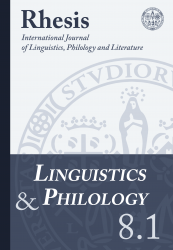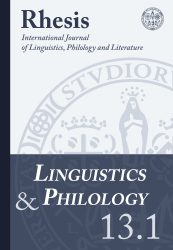| p. 5 | «L’acqua correva con tanto impeto». La rappresentazione linguistica delle esondazioni nel XVI secolo: primi rilieviRita FresuAbstract The paper draws the attention on the language of the Renaissance texts about floods starting from the analysis of some publications printed in the Sixteenth century in consequence of exceptional flooding of the Tiber (the “diluvi”). These documents represent a peculiar form of non-literary texts, which take different configurations: both brief reports and longer dissertations, structured in several parts, in which it is narrated how the event sparked off, also are discussed the causes of the phenomenon and the possible forecast, damages and consequences of owerflows, coping strategies. For such reasons this type of text represent a valuable source that allows to reconstruct patterns of perception and interpretation models of such a natural disaster. According to a historical-linguistic point of view the texts taken into consideration can be placed in the period of circulation of the Tuscan-Florentine model and, at the same time, in an important moment of expansion and stabilization of structures of the Italian language also in non-literary prose. The analysis focuses on the formal devices used to develop, narrate and linguistically represent such natural disasters, with particular reference to the syntactic-textual exposition and to semantic-lexical choices.
|
| p. 22 | L’enigma del hronæs ban nel Franks Casket: una proposta interpretativaNicoletta GhessaAbstract The article presents a new interpretation of the Old English hronæs ban enigma, carved on the front panel of the Franks Casket (Northumbria, 8th century). The riddle, consisting of two alliterative verses written in futhorc runes, describes the stranding of a ‘fish’, hinting at the beached whale from whose bones the casket was made – as the solution hronæs ban “whalebone” clarifies. Nonetheless, the opening hemistich of the first verse has proved cryptic because of its ambiguous syntax, which scholars tend to emend and interpret univocally. Through a detailed lexical analysis of the verses and of their intertextual references, the paper aims at showing that the syntax was, indeed, intentionally made equivocal, thus allowing a twofold reading of the text, both profane and sacred. In fact, from a secular perspective, the riddle could be read as a formula to activate the apotropaic occult power of the casket’s material, whalebone, whilst from a Christian one, it could be seen as a metaphor of the Flood. The article will focus on this latter analogy, examining the myth of the Flood in Anglo-Saxon culture, and exploring the possible reasons behind the mention of this biblical episode in the casket, first and foremost as an allusion to its being an ‘ark’, i. e., a storage box for valuables.
|
| p. 54 | Nuovi anglicismi nel discorso politico su TwitterEleonora MamusaAbstract This work aims at investigating the use of anglicisms in Italian political communication on the microblogging website Twitter. In particular, it focuses on neologisms, which play a rather significant role: more than 30% of the English loans detected in the analysed corpus is represented by words that have not been included in the most recent Italian dictionaries (2014), proving how these terms can rapidly enter everyday language without having achieved any official acknowledgement or gone through a standardization process. Although the main ascertained tendencies involving the process of lexical borrowing are mostly respected, it has also been possible to identify some peculiar and innovative traits in the use of anglicisms, not only from a strictly grammatical point of view but also as far as pragmatics is concerned. For instance, in a number of cases English loans are used to express key elements of political communication such as slogans, titles and announcements, which also confirms the fact that Italian speakers attribute a highly stylistic and pragmatic value to these adopted words. Novelty, freshness and cosmopolitanism are then often considered to be more important than other aspects of communication, namely transparency and the possibility for the addressee to fully understand the message.
|
| p. 77 | La morfologia verbale nel Breve Portus Kallaretani (ASP, Archivio Roncioni, ms. 322)Giulia MurgiaAbstract The so-called Breve Portus Kallaretani is a collection of provisions issued by the Comune of Pisa at the beginning of the 14th century to regulate the merchant activities of the port of Cagliari (Sardinia), at that moment under the Pisan control. Transmitted by a single witness (Pisa, Archivio di Stato, Archivio Roncioni, MS. 322), the Breve shows a Pisan phono-morfological basis, as evidenced by the analysis of its verbal system, although the presence of different copists makes it possible to notice some rare, but significant, phenomenons of interference with the Sardinian language.
|
| p. 111 | Il clitico [ŋkɛ] in sardo orgolese: dalla deissi all’aspettoCarminu PintoreAbstract The study above focuses mainly on the function of the clitic [ŋkɛ] and its use in ‘Orgolesu’, a variety of the Sardinian language. It has been the purpose of this study to provide a first overview of the function, semantics and grammaticalization of this clitic, which ranges from the spatial to the actional and the aspectual domains. The research framework chosen for this research is the theory of grammaticalization, defined as «an approach to language study, one that highlights the interaction of use with structure, and the non-discreteness of many properties of language» (Hopper and Traugott (2003 [1993]: xvi).
The clitic [ŋkɛ] showed to be an example of ‘polygrammaticalization’ as it has developed different grammatical functions in different constructions. As a matter of fact, it can encode ‘distance’ in locative and existential constructions as well as directional meanings such as ‘motion from’ and ‘motion towards’. In the aspectual domain, the clitic [ŋkɛ] codifies telic meaning and is therefore used to express change of state and perfective meanings.
To sum up, the aim of this research is to show that the multi-functionality and polysemy of the clitic [ŋkɛ] can be explained diachronically by examining its original meaning, and synchronically through its diverse uses. From an originally deictic basic meaning, the clitic [ŋkɛ] has grammaticalized and spread to perform actional, temporal and aspectual functions.
|
| p. 138 | Agnizioni indomediterranee. Contesti culturali, riflessi linguistici, evidenze testualiDomenico SilvestriAbstract The recognition of exposed children and the subsequent legitimisation of their identity through similarity with their mother’s feet was not an uncommon occurrence in the ancient Indo-Mediterranean area. More generally, it can be said that after being recognised, these children were often destined to accomplish great and sometimes terrible enterprises during their adulthood. Such endeavours often coincided with dynastic change or real turning points in history, while lack of recognition often resulted in even greater disasters. This important cultural trait is common to India (the stories of Karna and Rama), Iran (the story of Cyrus), Mesopotamia (stories of Gilgamesh and Sargon), Anatolia (the story of Suppiluliuma), Egypt and Israel (stories of Moses and Jesus), Greece (the stories of Paris, Melampus, Theseus, Oedipus, Orestes) and Rome (stories of Silvio and Romulus and Remus). These complex events share many cultural traits along with the associated linguistic reflections. The tragic story of Oedipus is one of the most striking, since his failed recognition (precisely because of his deliberately deformed feet at the time of his exposure as an infant) is transformed into incest and blindness as a form of self-punishment, which are both the negative reverse side of this coin.
|
| p. 176 | Un recente contributo su Marziale e l’epigramma longumSabrina SinisArticle |
 Linguistics and PhilologyVol. 8.1 - 2017
Linguistics and PhilologyVol. 8.1 - 2017
